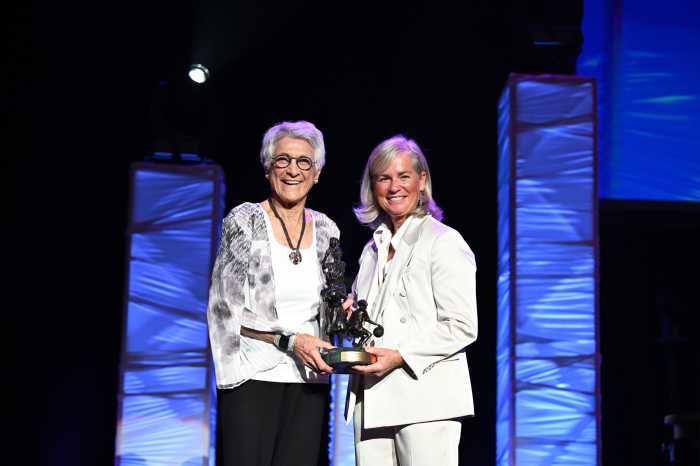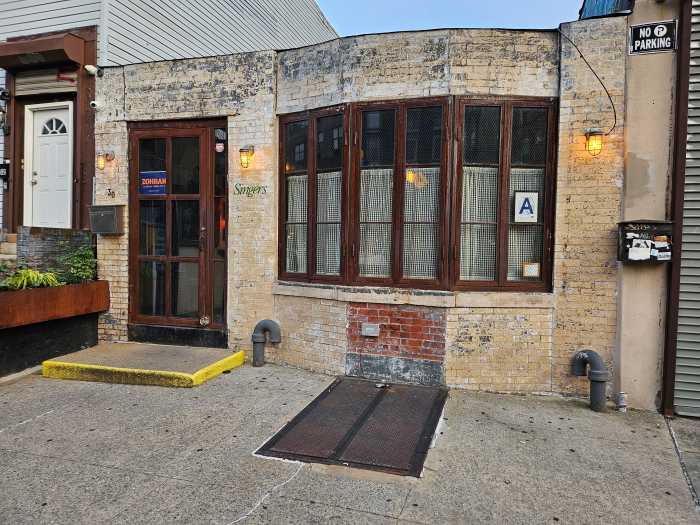By Bonnie Rosenstock
In the city ethos, we have an ambivalent, adversarial or impoverished relationship with what remains of nature. The urban squirrel, although arguably appealing, is nonetheless a nut-begging rodent with a bushy tail. But the pigeon is a pesky, ubiquitous rat with feathers and wings. However, for about a month a few springs ago, I had an up-close-and-personal encounter of the nature/nurture kind with a family of pigeons, and in this über-village we live in, or in my case, in the über-East Village, it was an awesome reminder of how that other side of the tree lives.
I first got a hint of some strange goings-on when more than the usual type of debris started blowing in through my slightly ajar bathroom window and landing on the inside tile ledge and into my bathtub; little bits of twigs, feathers and cotton strands appeared, accompanied by a lot of winged activity and commotion. I didn’t pay much attention to the ruckus until one day I opened up my window wider and was surprised with a walled barrier of tightly woven well-constructed nest. A few days later, two small, oval, white eggs magically appeared.
About a week later, there was a very heavy rainstorm with gale-force wind, and the two eggs were literally blown away. But Mother Nature does indeed provide, I discovered, and within a few days two identical eggs appeared. It seems that in order to compensate for high mortality rates, pigeons reproduce more rapidly. While a pigeon’s natural life span is actually 30 years, they only manage to survive for one or two stressful years in New York City, much like Wall St. brokers these days.
My curiosity piqued, I headed for my local Ottendorfer Library on Second Ave. and Ninth St. and checked out an ornithology book. I read that the pigeon has a prolonged breeding season of eight or more months, incubation lasts from two to four weeks, fledging period (when the young ones are dependent on their parents for food) lasts about 17 days, and post-fledging care is from two to four weeks. That adds up to a lot of pigeons — an estimated 80,000 in New York City in 2005 — and, as I was soon to learn first hand, a lot of poop.
According to the book, the male pigeon obtains the nest site and then advertises his availability by singing. I imagined the lyrics to be, “Have prime location. Will cohabitate. Rental, including deposit: two eggs.” Then when the mating is done and the egg or eggs (mostly two) are laid, both parents share responsibility for egg-sitting, the male taking the day shift, the female doing night duty. During this time, the pigeons are monogamous, that is, they remain together for a single breeding cycle or maybe for several within a season and work together to rear the young (unlike hawks and a few other birds that mate for life). Serial monogamy. Then they part amicably and take up with another. I was taking notes.
Several times a day I checked the nest for signs of life. Strangely, during the gestation period, the thought of eating eggs made me violently ill. Finally, the first one emerged, and then a little later, the other pecked through. Pigeons are born blind with little or no down, so they looked like raw, red, plucked chickens. I developed an aversion to eating chicken. Since the nestlings can’t walk or regulate their own body temperature, mama and papa are busy day and night, either feeding them or sitting on them to keep them warm or cool as need be. The nestlings are initially fed entirely on “pigeon milk,” i.e., a secretion of the crop (the pouch-like dilation of the bird’s gullet where food is broken up) or esophageal fluids of both parents that has the consistency of cream cheese. (“A bagel and shmeer, please.”) Regurgitated items from the parents’ vegetarian diet are later added to the “milk.” Instant Gerber. Equality in nurturing. “Honey, it’s your turn to regurgitate.”
As the saying goes, “What goes in, must come out,” and that’s when my love affair with nature came to an abrupt halt. When the nestlings are very small, the feces, which are encased in a gelatinous sack, are normally consumed by the adults. Because the digestive efficiency of the young is so low, significant nutrients remain in the sac, so this system acts as a natural recycling mechanism. With older nestlings, the black-and-white sacs are supposedly dropped away from the nest, our common biological imperative not to poop where we eat. Nestlings deposit on the rim of the nest. In this case, one side of the rim was the great outdoors. Unfortunately, the other side happened to be inside my apartment, and the droppings quickly began piling up on my bathroom shelf.
A single pigeon produces an average of 25 pounds of excrement per year. Pigeon droppings contain particular chemicals, specifically ammonia and uric acids, which can corrode city infrastructures and rust steel structures. Not only does this avian acid rain cause extensive damage to property, but the fowl mess also provides a growth medium for a fungus whose spores cause histoplasmosis, a potentially serious lung disease in humans, which may occasionally invade other organs. Infants, young children, older people and immunocompromised individuals, such as AIDS and cancer patients, are at increased risk for the disease. Bob Dylan, who was knockin’ on heaven’s door a few years back, was diagnosed with pericarditis, an infection that creates a swelling of the sack surrounding the heart, brought about by a serious form of the disease.
However, histoplasmosis is uncommon in New York City and is not contagious; it cannot be transmitted from an infected person or animal to another (unlike SARS and avian flu). According to 1999 statistics from the New York City Department of Health, there were only 15 cases reported among New York City residents, a rate of 0.2 cases per 100,000 persons. Since the fungus Histoplasma capsulatum grows in soil and material contaminated with bat and bird droppings, if we don’t frequent bat caves, chicken coops or pigeon roosts, we are essentially safe.
The nauseating, acrid smell was now overwhelming. I could no longer keep my window open. Since my window is frosted and I cannot see out, I would hold my breath and open it slightly once in a while to take a quick peek at their development, now anxious for the day they would grow up and fly the coop. Like typical teenagers, the older they got, the messier, smellier and more wrecked the nest became.
Finally, the day arrived. Through an adjacent living room window I watched them take their first, short, tentative fluttery-winged flights, mama and papa guiding them. A few days later, they were gone. I took a deeply held breath and knocked down the trashed, poop-filled nest and poured boiling water and bleach on the outside concrete ledge. But for a few weeks, one or two familiar-looking young pigeons came back to perch there and coo their soulful pigeon song. Please don’t squat, I whispered. No vacancy.





































